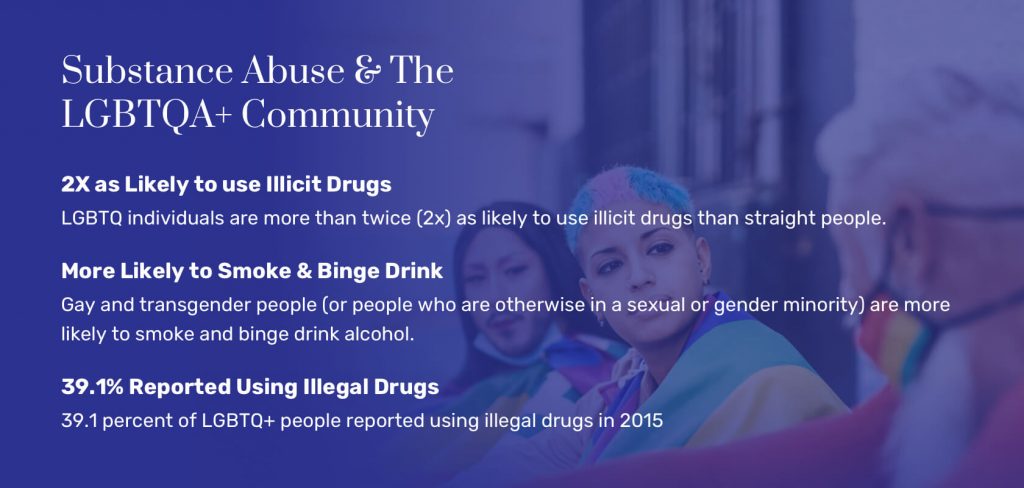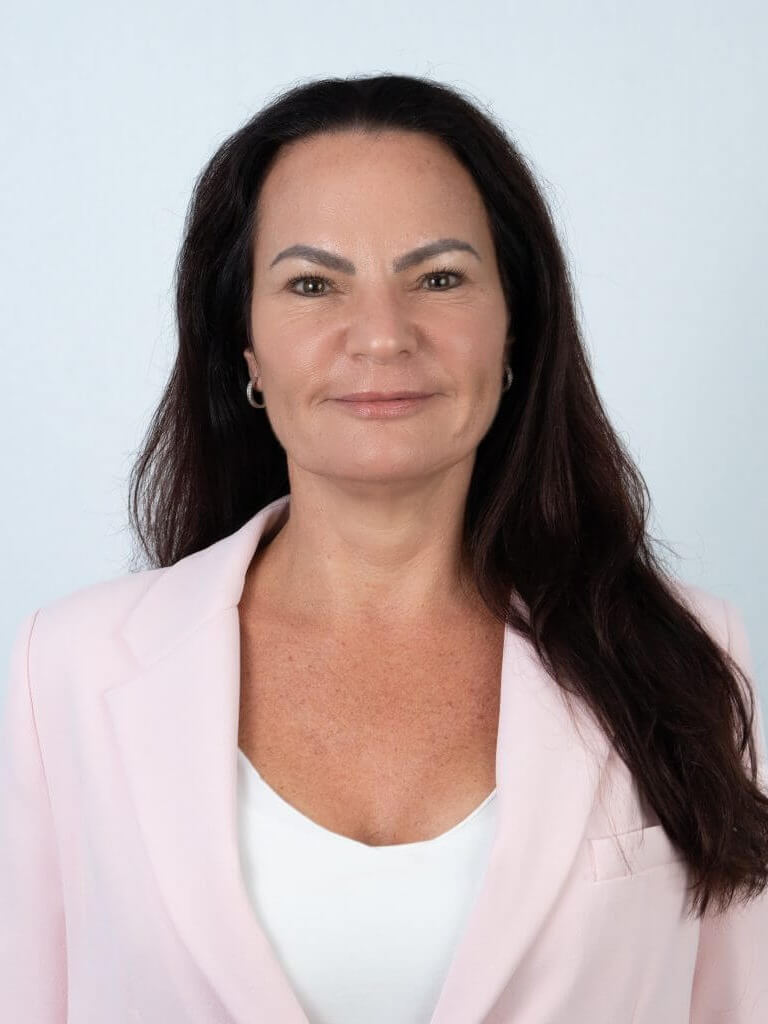
LGBTQ+ People & Substance Abuse
In 2015, the Substance Abuse and Mental Health Services Administration reported that LGBTQ individuals are more than twice as likely to use illicit drugs than straight people. Gay and transgender people (or people who are otherwise in a sexual or gender minority) are more likely to smoke and binge drink alcohol. In the same year as the SAMHSA report, 39.1 percent of LGBTQ+ people reported using illegal drugs.
Rates of drug and alcohol abuse are much higher in the LGBTQ+ population than in the general population for a number of reasons. Many gay and trans people face homophobia and transphobia (respectively) on a day-to-day basis, impacting where they work and where they live. This also impacts their relationships, their family ties, and their spiritual lives.
Even as the last couple of decades have seen incredible improvements for gay and trans rights, many people who identify as LGBTQ+ are still the victims of many forms of social prejudice and stigma. This leads to dangerous levels of stress, self-esteem issues, anxiety, and depression, one or all of which can contribute to the development of a substance abuse problem.
Stress & Discrimination
In sociological terms, it is known as “minority stress,” defined by the American Psychological Association as the experience of members of a minority group within a larger social environment. In this case, it’s people of a gender or sexual minority being out of place wherever they live, especially if the communities in which they live do not support or approve of them being gay, trans, or otherwise queer.
The Center for American Progress writes that upward of 43 percent of gay people have been professionally discriminated against for being gay. As many as 90 percent of transgender people experience “harassment or mistreatment on the job.”
In 2013, the American Journal of Public Health, on the topic of “Stigma, Mental Health, and Resilience in an Online Sample of the US Transgender Population,” wrote that transgender people “clearly fit the minority stress model.” Of the 1,093 trans people surveyed in a study, 44.1 percent reported clinical depression, and 33.2 percent reported anxiety. In both cases, this was a direct result of stress caused by discrimination and hostility they had experienced for being transgender people.
This is a big reason why substance abuse is so prevalent across transgender communities. Because of the minority stress, trans people have a greater risk for participating in dangerous behavior like sex work (the Journal of Trauma Dissociation writes that transgender women in sex work has its roots in “systemic, institutional, and interpersonal discrimination”), which raises the issue of transgender people being more likely to get HIV-AIDS. There is also drug abuse among the larger transgender population at a rate significantly higher than that of the general population.

Drug Use in LGBTQ+ Communities
Many people in a situation like this turn to drugs or alcohol to cope with the depression or anxiety that they are experiencing; they may do so under the belief that the temporary escape offered by the chemical substances will have lasting effects, or because alcohol and tobacco companies market their products to gay people at a disproportionately high rate (so much so that in 2018, the American Journal of Public Health called for an “intervention” to get alcohol and tobacco corporations to stop exploiting the vulnerabilities of the gay populations they were targeting).
The Advocate noted in 2013 that “[gay and transgender] culture very heavily revolves around the bar scene,” which not only increases the likelihood that gay and trans people experiencing depression and anxiety because of their respective orientations will try to self-medicate with alcohol and/or drugs, but that they will likely be exposed to marketing that encourages alcohol and/or drug use in the places they go to socialize without fear of stigma.
Cultural Competency
Another challenge for LGBTQ+ people is that there is a disparity in cultural competency in health care systems, where doctors, nurses, counselors, caseworkers, and other professionals are not adequately trained to work with gay and trans patients or clients. The professionals may be unaware of the unique challenges faced by gay/trans people, or they may not be able to suggest treatments that are applicable to their lives.
Additionally, many LGBTQ+ people fear further discrimination and harassment in medical settings, which dissuades them from seeking treatment. Their problems deepen, and they continue to seek self-medication in the form of drugs and alcohol.
Even some that offer “LGBTQ+” programs were not functionally different than facilities that offer similar treatment to the general population. A telephone survey found only 7.4 percent of treatment facilities could identify a specific service they offered that was designed for LGBTQ+ clients.
However, a lot has changed for gay and transgender people, and many parts of the country do offer access to treatment programs that are staffed by people who are trained in addressing the psychological needs of LGBTQ+ individuals since these needs are distinct from those of heterosexual people. A big factor is that straight people will likely not experience the effects of having to be “closeted,” while this is a burden many gay and transgender people carry.
To that point, LGBTQ+ rehab centers (or treatment facilities that have LGBTQ+ people on staff, or staff members who have been trained in the appropriate cultural competency) can identify any co-occurring mental health disorders (like depression, anxiety, and minority stress). This helps in the creation of a treatment plan that promotes long-term healing and recovery from substance abuse.
Without this component — for example, if an LGBTQ+ person’s treatment was not sensitive to their identity as a sexual/gender minority — there is a greater likelihood that the care would be insufficient, leading to a worsening mental health balance and relapse.

Drug Trends in LGBTQ+ Communities
What kinds of drugs do LGBTQ+ people tend to use?
- Tobacco: LGBTQ+ people smoke more than straight people, and they are less likely to try and quit.
- Alcohol: Up to 25 percent of the LGBTQ+ community has moderate to severe rates of alcohol dependence.
- Cannabis: Research has found that gay men are 3.5 times more likely to use cannabis than their heterosexual counterparts.
- Heroin: LGBTQ+ people are 5 times more likely to use heroin than the general population.
- Stimulants: https://www.publichealth.columbia.edu/public-health-now/news/lgb-individuals-use-stimulants-higher-rates-heterosexuals
Helping an LGBTQ Person Cope With Addiction
There are many ways to help an LGBTQ+ person cope with addiction. A key part of this is to create an inclusive and accepting space for them. Validating their sexual/gender identity, and the problems that are associated with being in that minority, is vital for creating a workable, long-term plan for them.
A good way to do this is to remind the person that they are loved for who they are, sexuality and gender included. For parents of LGBTQ+ children, this is especially important. Rates of drug use among LGBTQ+ youth are incredibly high.
In more professional settings, that kind of acceptance could be seen in the form of equal opportunities and rights. In public settings, it could look like businesses providing equal services to their gay and transgender clients without discrimination.
All these pieces contribute to the larger picture of an LGBTQ+ person feeling supported and seen in their recovery. Bolstering their self-esteem opens the door for gay and transgender people to be able to articulate their problems and seek out help when they know something is wrong. This is especially true for LGBTQ+ people who have experienced discrimination or ostracization directly as a result of their sexual and/or gender identity.
One tangible way to help an LGBTQ+ person who is struggling with substance abuse is to discuss alternative coping methods with them. Everything from yoga and art to regulating their sleep patterns and eating healthier can contribute to breaking the hold of drugs or alcohol.
A gay or transgender person knowing that they’ve got someone (or people) looking out for them, who are willing to check in on them and participate in some of these practices with them, will go a long way in helping the person commit to their new and improved behavior, and start to move away from drugs or alcohol.
Getting Treatment for Substance Abuse
The biggest way to support an LGBTQ+ person who is dealing with substance abuse is to encourage them to go to treatment. For gay and transgender people, this is complicated by the fact that they have likely been made to feel ashamed for their identity, and knowing that health care practices are not always equitable to people of a sexual or gender minority.
However, substance abuse is a multifaceted medical problem. For all the good intentions and ideas of friends or loved ones, it requires professional intervention.
Despite how challenging it can be for LGBTQ+ people to access appropriate drug recovery programs, there are many treatment and rehabilitation centers across the country that are welcoming to gay and transgender people. These offerings have programming that addresses the unique needs of being a gay and/or a transgender person.
Many of these programs will begin the process of treating a substance abuse problem with a detoxification phase. This can help the person break their physical dependence on the chemical substances they have been abusing.
Depending on the degree of substance abuse, as well as the person’s home environment and personal situation, they may be encouraged to enroll in other care options. These include the following:
- Inpatient treatment: This is residential care, with around-the-clock care and observation.
- Partial hospitalization: This is also around-the-clock care, but with less observation.
- Intensive outpatient: Patients can reside outside the treatment center, but they are expected to check in for treatment and therapy daily.
- Outpatient: This care often helps patients transition from formalized care to ongoing recovery.
- Aftercare: This is long-term, ongoing care that works to guard against relapse.
These programs are often customized to address the specific needs of each person, in terms of the specific substance that was abused, how long the abuse had been going on, or whatever other factors in the person’s life might have contributed to the substance abuse.
However, not all addiction treatment centers are standardized to meet the unique needs of LGBTQ+ patients. Some, for example, might not have the language to address same-sex relationships. Others might not have the resources to help transgender people with the issues they face in their lives.
Treatment Guidelines for LGBTQ+ Clients
Thankfully, there are solutions. The Substance Abuse and Mental Health Services Administration created guidelines for treatment providers, to make traditional rehabilitation facilities more inclusive of gay and transgender people. The point of the guide is to help substance abuse treatment providers increase the effectiveness of their work with LGBTQ+ patients and to encourage LGBTQ+ patients to seek out help for their addiction problems.
The guidelines include the following:
- Be more understanding of the issues unique to gay and transgender people, and be more flexible in responding to those problems.
- Provide a complete, holistic approach.
- Be consistent with the cultural needs of LGBTQ+ individuals.
- Promote healthy self-esteem among LGBTQ+ clients.
- Encourage healthy behaviors.
- Support group decision-making.
- Reduce barriers to treatment for LGBTQ+ people.
- Provide evidence-based treatment.
- Create a community of recovery.
Gay and transgender people looking for substance abuse treatment might also be able to find treatment centers that have programs that are specifically designed for sexual and gender minorities. These centers offer similar programming to traditional facilities, but focus on issues that are specific to their LGBTQ+ clients, covering everything from nontraditional families, to having to remain closeted, to taking detoxification medication while still on hormone replacement therapy.
A key factor in these specialized treatment facilities is that the staff members are explicitly trained on how to meet the needs of their gay and transgender clients. Some staff members might themselves be LGBTQ+. Some institutions were even founded by gay or transgender people, precisely to address the dearth of options that kept many LGBTQ+ people away from recovery treatment for so long.
It is important to note that no two LGBTQ+ treatment facilities are the same. Each individual facility will have its own approach to the length and intensity of their respective programs while still following the research-based methodology of the overall drug rehab paradigm.
Some LGBTQ+ treatment centers will be categorized by sexual orientation. Others will serve a wider range of gender and sexual identities.
For gay and transgender clients, these facilities are ideal because of how they specifically work with clients to treat, and cope with, the various stressors that are associated with LGBTQ+ identity and substance abuse, including discrimination, rejection, coming out, and homophobia and/or transphobia.
- Sexual Orientation and Estimates of Adult Substance Use and Mental Health: Results from the 2015 National Survey on Drug Use and Health. (October 2016). Substance Abuse and Mental Health Services Administration.
- Why the Gay and Transgender Population Experiences Higher Rates of Substance Use. (March 2012). Center for American Progress.
- The Minority Stress Perspective. (April 2012). American Psychological Association.
- Gay and Transgender People Face High Rates of Workplace Discrimination and Harassment. (June 2011). Center for American Progress.
- Stigma, Mental Health, and Resilience in an Online Sample of the US Transgender Population. (May 2013). American Journal of Public Health.
- Transgender Women and the Sex Work Industry: Roots in Systemic, Institutional, and Interpersonal Discrimination. (2014). Journal of Trauma Dissociation.
- HIV Disproportionately Affects Transgender Women. (April 2020). American Journal of Managed Care.
- Transgender Rights Critical for the Health of 25 Million Transgender People Worldwide. (June 2016). Science Daily.
- “Freedom” and “Choice”: How Cigarette Companies Target the LGBTQ Community. (July 2015). Slate.
- Tobacco Policies and Alcohol Sponsorship at Lesbian, Gay, Bisexual, and Transgender Pride Festivals: Time for Intervention. (February 2018). American Journal of Public Health.
- Op-Ed: Why Aren't We Talking About Alcoholism? (March 2013). The Advocate.
- Cultural Competence in the Care of LGBTQ Patients. (January 2021). Treasure Island.
- Do Specialized Services Exist for LGBT Individuals Seeking Treatment for Substance Misuse? A Study of Available Treatment Programs. (2007). Substance Use and Misuse.
- The LGBT Community: A Priority Population for Tobacco Control. American Lung Association.
- Substance Use in Lesbian, Gay, and Bisexual Populations: An Update on Empirical Research and Implications for Treatment. (November 2011). Psychology of Addictive Behaviors.
- Tobacco, Marijuana Use and Sensation-Seeking: Comparisons Across Gay, Lesbian, Bisexual and Heterosexual Groups. (December 2010). Psychology of Addictive Behaviors.
- Severity of Alcohol, Tobacco, and Drug Use Disorders Among Sexual Minority Individuals and Their “Not Sure” Counterparts. (January 2019). LGBT Health.
- How to Support Your LGTBQ Child. (February 2020). Today.
- LGBTQ Inclusion in the Workplace: Updating Policies and Training. (June 2020). Society of Human Resource Management.
- Social Support, Discrimination, and Self-Esteem in LGBTQ + High School and Post-Secondary Students. (August 2020). Journal of LGBT Youth.
- Coping With Different Types of Depression. (April 2019). US News & World Report.
- Treatment Approaches for Drug Addiction. (January 2019). National Institute on Drug Abuse.
- Lesbian, Gay, Bisexual, and Transgender (LGBT). (July 2021). Substance Abuse and Mental Health Services Administration.
- A Provider’s Introduction to Substance Abuse Treatment for Lesbian, Gay, Bisexual, and Transgender Individuals. (2012). Substance Abuse and Mental Health Services Administration.




